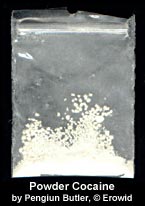Cocaine
Basics
DESCRIPTION #
Cocaine is a naturally derived CNS (central nervous system) stimulant extracted and refined from the Coca plant grown primarily in the Andean region of South America. Cocaine is typically a white-ish powder with a bitter, numbing taste. It is most often insufflated (snorted), though it can also be injected and used orally.
While powder cocaine can be smoked to some effect (despite common belief otherwise), it is a very inefficient method of ingestion. Because of the high temperatures present when smoking, powder cocaine tends to burn rather than vaporizing. For this reason, freebase cocaine, also known as crack in its street form, is created from powder cocaine for smoking. Freebase cocaine vaporizes at smoking temperatures providing more effect with less material, as well as faster onset and a more intense high than powder cocaine.
While powder cocaine can be smoked to some effect (despite common belief otherwise), it is a very inefficient method of ingestion. Because of the high temperatures present when smoking, powder cocaine tends to burn rather than vaporizing. For this reason, freebase cocaine, also known as crack in its street form, is created from powder cocaine for smoking. Freebase cocaine vaporizes at smoking temperatures providing more effect with less material, as well as faster onset and a more intense high than powder cocaine.
Dose #
Dose Summary Needed.
Price #
In the United States in 2011, powder cocaine is sold for around $20-30 for 0.25 gram, $60-100 per gram, and $120-200 for 3.5 grams (1/8 ounce).
Cocaine is illegal to possess and sell in the United States (schedule II) and in most other countries. It became a regulated substance in 1914, as one of the first substances to be made illegal in the U.S.
Chemistry #
The chemical name for cocaine is benzoylmethyl ecgonine (C17H21NO4). It is a bitter, white, odorless, crystalline drug.
Pharmacology #
Pharmacology Summary Needed.
Production #
Production Summary Needed.
Coca leaf chewing has been practiced for thousands of years. Cocaine was first isolated from the Erythroxylon coca plant around 1850. Medicinal use of Cocaine increased through the late 19th century and recreational use started to become a known problem in the early 20th century. Recreational use was banned in the United States in 1914.
Terminology / Slang #
The Substance:
Cocaine: Coke; Snow; Nose Candy; Dust; White Lady; Toot; Llello.
Freebase Cocaine: Crack; Rock.
Freebase Cocaine: Crack; Rock.
The Experience:
Coked up.
As with many substances, the effects of cocaine depend greatly on the person and the dose. Possible effects include feelings of well-being, decreased appetite, stimulation, sexual arousal, and increased focus. Negative effects can include increased body temperature and heart rate, agitation and anxiety, paranoia, dizziness, nausea/vomiting, violent behavior, kidney failure, seizure, stroke, and heart attack.
Onset #
Onset varies depending on method of ingestion. Snorting cocaine will produce effects within a minute. Smoking freebase cocaine produces effects almost immediately...often before exhaling. Injected cocaine also produces effects within a few seconds.
Duration #
The effects of snorted cocaine are quite short with the primary high lasting only 20-40 minutes. This is one of the reasons leading to problems with addiction. As the effects wear off, more is often snorted. This pattern of repeated use can quickly move in the direction of addiction. A hit of smoked Crack (freebase cocaine) will typically produce effects lasting 5-15 minutes.
Visual Effects #
Visuals Summary Needed.
PROBLEMS #
Street cocaine is quite often impure. The more direct the route of administration, the more dangerous this can be. Injecting impure cocaine can be deadly. Repeated snorting can cause severe damage to the nose. Smoking of freebase cocaine can cause breathing difficulties.
Contraindications #
- Research shows that cocaine use during pregnancy may increase chances of miscarriage, premature labour, and stillbirth.
- Cocaine is likely to be passed to a child during breast-feeding, resulting in irritability and lack of appetite in the baby.
Addiction Potential #
One of the most problematic aspects of cocaine is its addictive qualities. While cocaine is not believed to be physically addicting, it is, without a doubt, psychologically addicting. Those who use cocaine heavily or regularly frequently encounter great difficulty ceasing use.
Many people find themselves drawn to overusing both crack and powder cocaine. Initial tolerance develops rapidly, especially with heavy use, though tolerance appears to level off relatively quickly (users do not generally require more and more material over time, once they have reached heavy use).
Many people find themselves drawn to overusing both crack and powder cocaine. Initial tolerance develops rapidly, especially with heavy use, though tolerance appears to level off relatively quickly (users do not generally require more and more material over time, once they have reached heavy use).
Long Term Health Problems #
Long Term Health Problems Summary Needed.
Risk of Death #
Risk of Death Summary Needed.
CAUTION & DISCLAIMER #
Erowid Basics pages are summaries of data gathered from site visitors, government documents, books, websites, and other resources. We do our best to keep this information correct and up-to-date, but the field is complex and constantly changing. Information should always be verified through multiple sources.


